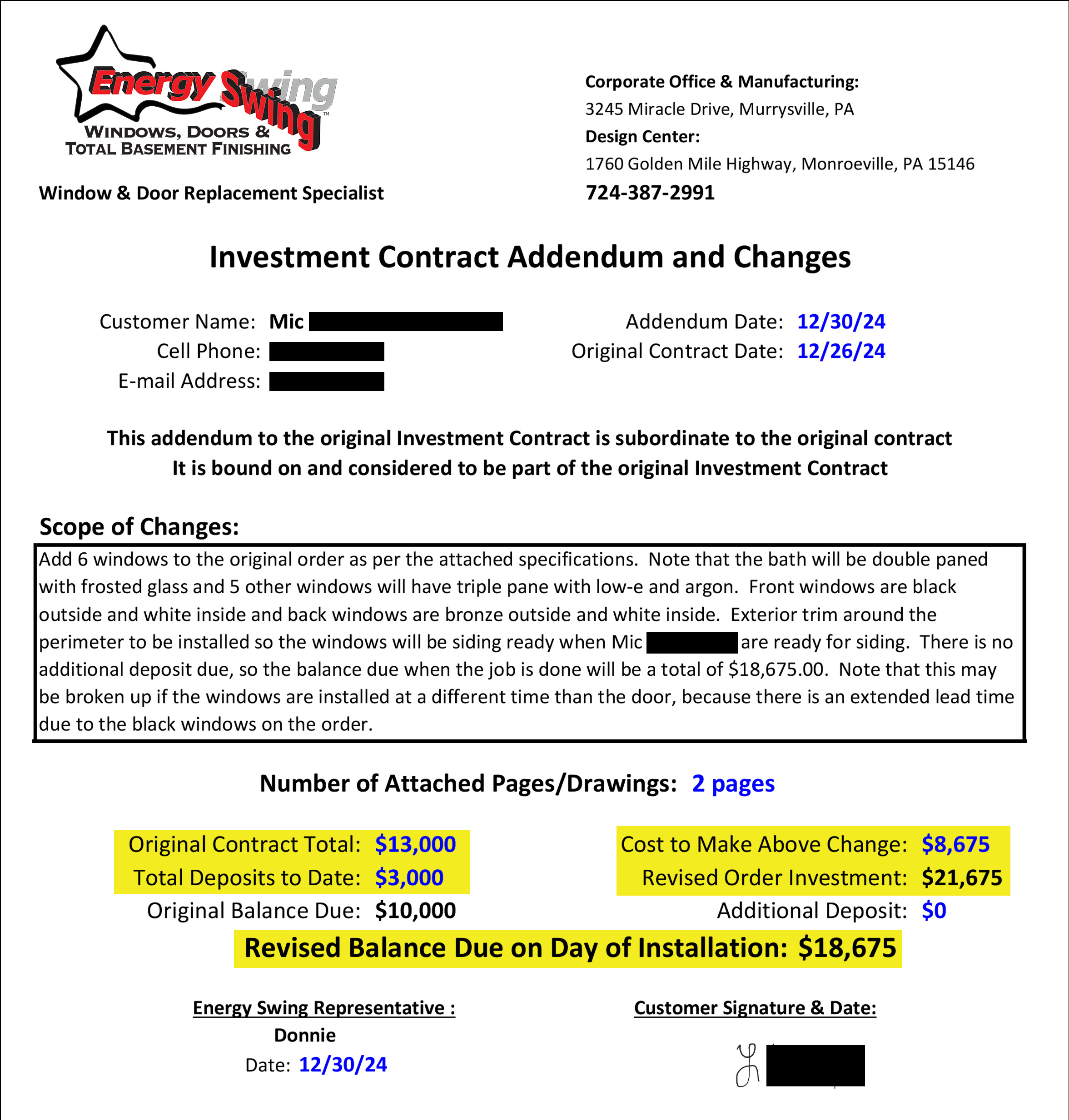If you’re planning a home improvement project in Pittsburgh, whether it’s replacing windows, upgrading doors, or finishing your basement, you might encounter a change order along the way.
Change orders in home improvement projects can be frustrating. You’ve spent time planning every detail, only to hear that something needs to be changed—possibly increasing costs and delaying your project.
At Energy Swing Windows, we’ve helped hundreds of homeowners navigate change orders with transparency and confidence. We know that, when handled correctly, change orders don’t have to derail your project.
In this article, you’ll learn the most common reasons for change orders, how they affect your timeline and budget, and—most importantly—how to minimize them.
Key Takeaways for Pittsburgh Homeowners
- Change orders modify your project contract, sometimes increasing or decreasing costs.
- They can be caused by measurements, hidden damage, design changes, or code updates.
- A clear, signed process reduces delays and misunderstandings.
- Ask questions, get everything in writing, and work with a transparent contractor.
What Is a Change Order in Home Improvement and Why Do They Happen?
A change order is a written document signed by all parties that modifies the original contract for a project. It accounts for any additions, subtractions, or changes to the original scope of work.
Change orders commonly arise due to unforeseen conditions or when a homeowner adds upgrades or adjusts the project. This usually happens before installation begins.
While many assume change orders always add work, they can sometimes remove unnecessary elements, leading to cost savings.
4 Most Common Reasons Pittsburgh Homeowners Get a Change Order
There are four common types of change orders and they usually occur for one of the following reasons:
1. Final Measurements Can Reveal Issues
A measurement specialist verifies project details before ordering materials. Sometimes, size restrictions or structural factors require adjustments.
2. Hidden Damage Uncovered During Work
Contractors may discover rotted framing, water damage, or foundation issues that must be addressed to ensure a quality outcome.

3. Homeowner-Initiated Design Changes
Homeowners sometimes adjust the project scope, such as adding or removing windows or upgrading trim work.
4. Code Compliance and Permit Adjustments
Contractors may find that local building codes require additional work, leading to necessary plan changes.
Real-World Examples of Change Orders
- A homeowner switched from 3-panel casement windows to 3-panel sliders, reducing costs by $3,900 with no impact on the timeline.
- Another project added six windows, increasing the cost by $8,675 and extending the timeline due to the lead time for black vinyl exterior windows.
Will a Change Order Delay My Home Improvement Project?
Depending on the type and timing of a change order, it may either extend or minimally impact the project timeline:
- Minor Adjustments: Depending on when they’re made, changes that don’t need extra materials or labor may have little to no effect on the timeline. Minor adjustments could include adding more windows and changing glass types for more privacy.
- Major Additions or Special Order Materials: If a change order requires special order items, the contractor may pause work until materials arrive. This might delay completion. Unforeseen structural issues could extend the installation time but rarely delay the project’s start.
While delays are possible, a well-managed change order process minimizes disruptions.
How to Make Change Orders Stress-Free and Stay on Budget
Even when a change order is necessary, a clear process can keep your project on track and reduce stress. Proper documentation and communication help homeowners budget effectively. Key steps include:
- Document Every Change Clearly: Every change order should detail the work, costs, and approvals to avoid surprises. Even something as simple as a color change requires a change order. To make sure everyone is on the same page moving forward, all changes should be signed off by both parties.
- Understanding Material and Labor Adjustments: Some changes may require significant modifications, while others may only involve small pricing fluctuations for additional materials needed. Knowing the costs involved with the materials will keep you aware of the price fluctuation.
- Avoid Unnecessary Change Orders: If a change order isn’t well-defined, it could lead to further unexpected modifications and costs. Work with a trustworthy contractor who clearly defines project details upfront.
Steps to Take When You Receive a Change Order
When presented with a change order:
- Discuss It with Your Contractor: You should never receive a change order without discussing it first with your contractor. A reputable contractor explains why the change is necessary and how it affects the project.
- Review the Details: Understand the reason for the change and the impact on cost and timeline before approving.
- Ensure Everything Is Documented: All approved changes should be in writing to prevent miscommunication and unexpected costs later.

Signs Your Contractor Might Be Using Change Orders to Overcharge You
Homeowners sometimes worry that change orders are a way for contractors to inflate costs unfairly. While legitimate change orders address necessary adjustments, there are red flags to watch for:
- Vague or Unexplained Changes: A reputable contractor should clearly explain why a change is needed and provide documentation.
- Unexpectedly High Costs: If a change order significantly increases costs without a clear reason, get a second opinion.
- Frequent or Last-Minute Changes: Excessive change orders could indicate poor initial planning.
A trustworthy contractor will discuss potential changes upfront and be transparent about costs and timelines. If something feels off, don’t hesitate to ask questions or request clarification.
Stay Informed and Avoid Surprises
Now that you understand what change orders are, you can confidently navigate them during your home improvement project. At first, you may have been worried about unexpected costs or delays, but working with the right contractor makes all the difference.
Before signing a contract, always ask your contractor how they handle change orders and get everything in writing. At Energy Swing Windows, we believe in full transparency, clear communication, and fair pricing.
If you’re planning a home improvement project in Pittsburgh and want a contractor who handles change orders with transparency, contact Energy Swing Windows today. We’ll help you keep your project on time and on budget, without surprises



